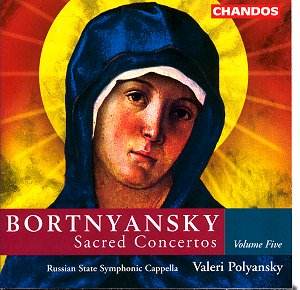Chandos are to be congratulated for determinedly issuing
this series of Sacred Concertos, less than standard fare in a time when
finances in the record industry are at a precarious low and too many
companies seek shelter in an endless stream of reissues. These recordings
sat in the vaults for just over a decade and we should be thankful that
they have seen the light of day.
Bortnyansky occupied a position of some power in his
day. In 1816, Tsar Alexander gave him the position of (basically) official
censor of music: all pieces sung in churches had to have the composer’s
approval. Prior to this, Bortnyansky had studied in Italy (having been
awarded a scholarship in 1769), where he wrote three operas, and the
influences of that country were to remain with him.
This is the final volume of the Sacred Concertos. No
less a figure than Tchaikovsky edited them (for Jurgenson in 1881/2)
and was said to have commented on their operatic leanings. Certainly
within the confines of the Sacred Concertos on this disc (Nos. 30-35)
there is a wide variety of mood and technique, from the openly celebratory
last movement of No. 31 (‘For God is the King of all the Earth’) to
the intensely lyrical and heartfelt opening of No. 30 (‘Hear my voice,
O God’: the most extended movement on the disc). There is also delicacy
here (the third movement of No. 33, ‘Yea, as I walk through the valley
of the shadow of death’), and the marvellously lightened textures of
the first movement of No. 35 (‘Lord, who shall abide in thy tabernacle?’)
reveal just how sensitive a response these Concertos demand.
The Russian State Symphonic Cappella is more than well-equipped
for this challenge. The choir’s technique is outstanding (listen to
how they cope with the cruelly exposed top line in No. 34’s ‘But let
the righteous be glad’). More than this, they display almost chameleon
responses to Bortnyansky’s music. The suggestion of restrained joy in
the final movement of No. 35 (‘He that doeth these things shall never
be moved’) is the perfect way to bring the disc to an end. Polyansky’s
sense of timing seems always spot-on, and the recording is exemplary,
capturing the cathedral acoustic convincingly.
Colin Clarke


